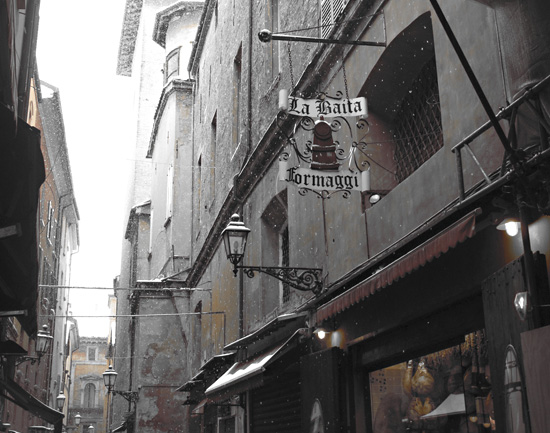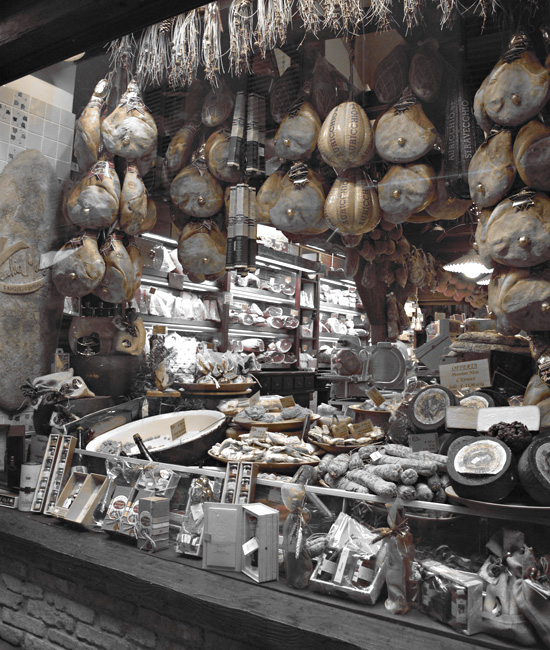
by Maureen | Jun 27, 2010 | Featured Articles, Food!, Journal, Meals, Quips
It’s hot. It’s sunny. And this weather is exactly what tomatoes love. They are deep red, full of flavor and SWEET! Some I buy directly from the farm down the road. Some come from Sicilia. It is tomato heaven and there’s no reason to eat anything else except as an accompaniment to the tomatoes: fresh basil, fresh mozzarella, olive oil, oregano, bresaola, bruschetta, etc. Ahh! You should be here!

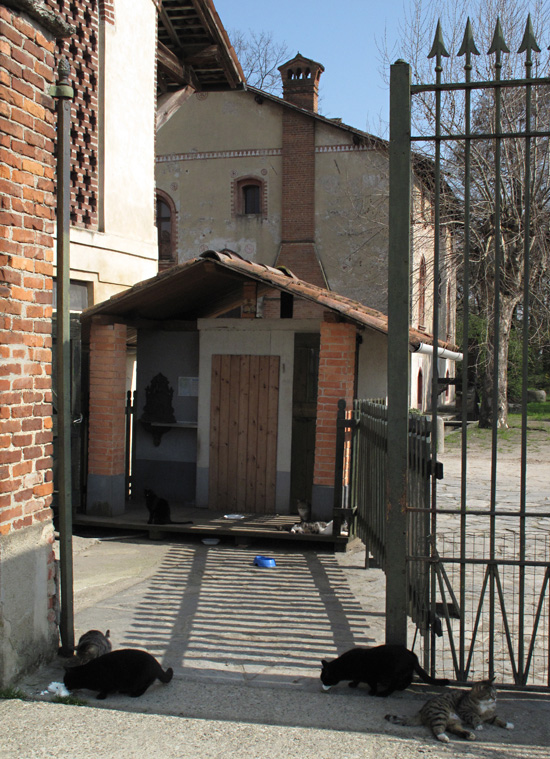
by Maureen | Apr 7, 2010 | Canals, Cheese, Discoveries, Featured Articles, Food!, Journal, Photo of the Day, Photos, Shopping & Markets
Wednesday is “ricotta day”, the day they make fresh ricotta at the Cascina Femegro.

Even though I had just been there yesterday, a sunny afternoon and the thought of hours-fresh ricotta on some nice bread easily convinced me to hop on my bike. I headed south along the canal, and turned west into the farmland.
There are old, stone troughs spanning the drainage ditches that wind through the farmland.
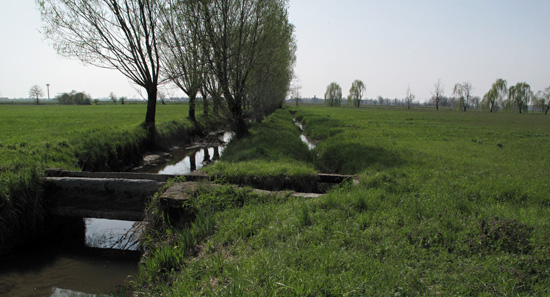
The one-lane road is cyclists’ heaven. Add sunshine overhead on a spring day, and it’s perfection.
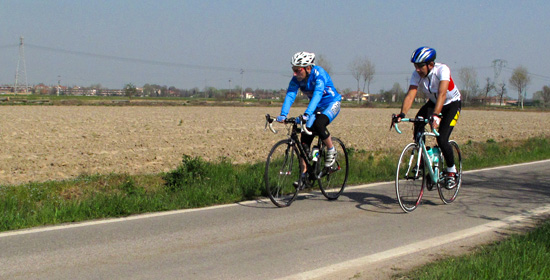
I bought 4 tubs of cheese: 1 for me, and 3 to give away to friends. I had no idea at the time that “friends” would include 9 cats in a lazy-but-playful huddle at another farm along the way home. They very cautiously came over to me as I crouched at the road side, did the “kitty squeak” and rubbed my fingers together trying to entice them. I’ve seen them there before, either on or under the roof of the small outbuilding at this historic building. The most affectionate was the tabby mamma cat that wallowed in the attention.

“OK”, I thought, “The ricotta was cheap. These kitties would enjoy it so much.” Yes. I unwrapped a domed mound of ricotta and split it up into several locations, allowing the timid cats to have a bite to eat away from the more dominant cats. After eating ’til their bellies were full, each found a spot in the sun and did their contented cat preening.
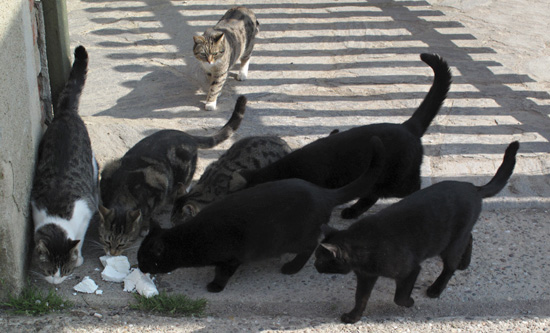
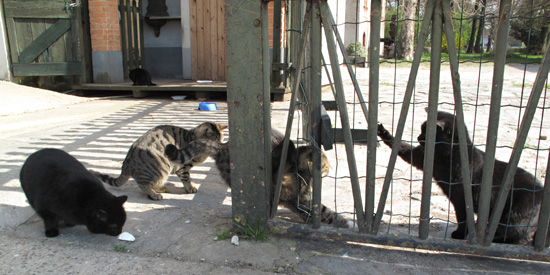
It was nice to get my “kitty fix” since I’m catless here in Milano (and since my kitty, Laddie, has died back in Seattle during my absence).
I wonder what the farmer will think when he finds the empty ricotta tub, and some remnants of cheese…
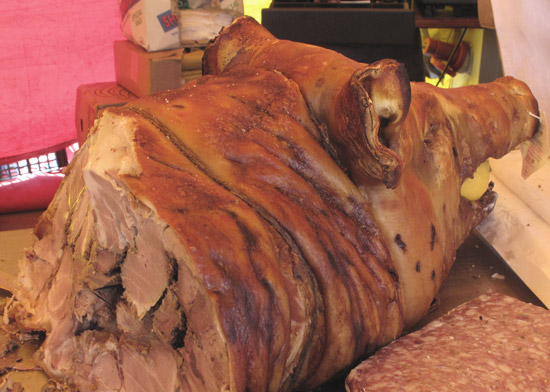
by Maureen | Apr 1, 2010 | Cheese, Discoveries, Featured Articles, Firenze, Food!, Incredible Locations, Journal, Photo of the Day, Photos, Shopping & Markets
After the flea market at Piazza dei Ciompi in Firenze last Sunday, I walked a few blocks further and saw yellow-tented stalls. Hmm. A food market: cheeses, meats, breads and a few other goodies. Some from Toscana (Tuscany), Firenze’s region. Some spicier ones from the south.
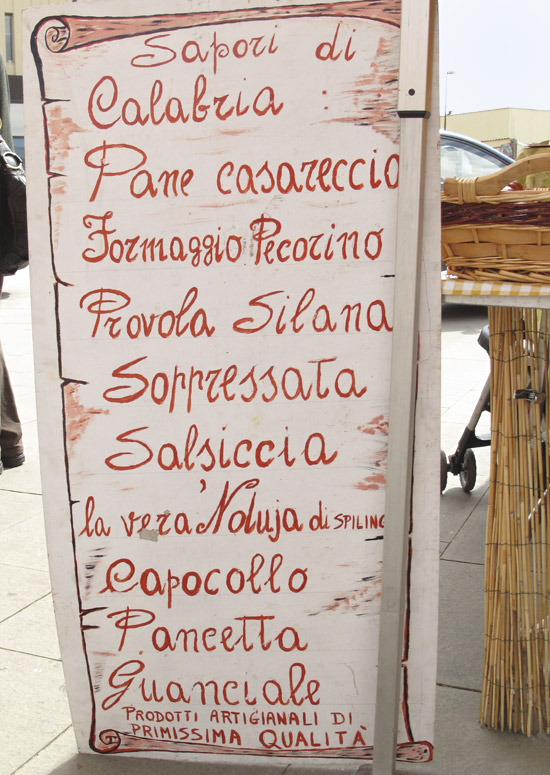
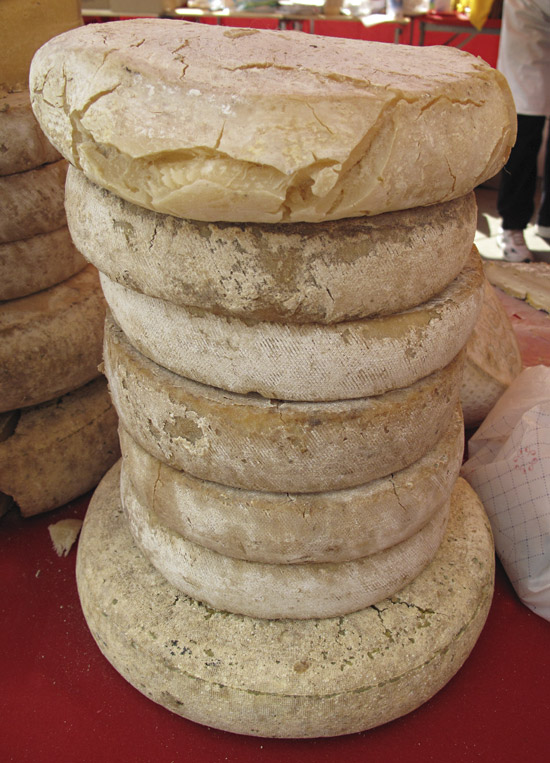
‘Nduja is a casing-stuffed meat that is spicy and spreadable. Very nice with good bread.
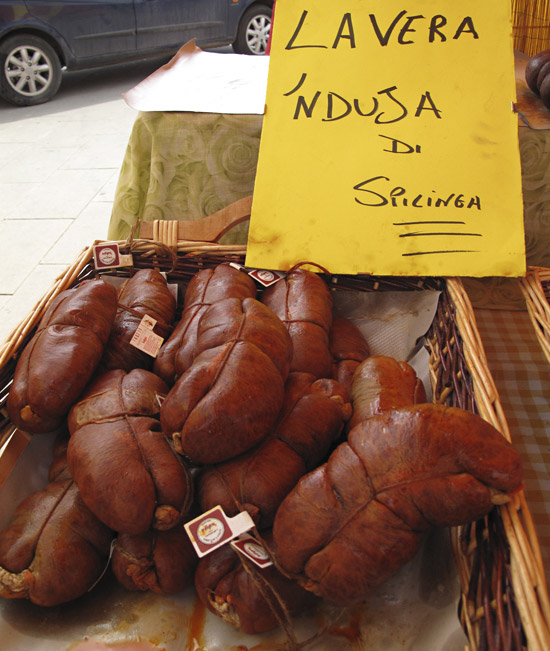
“Do you have a problem with cholesterol? Diet? The solution is Tometta (cheese) of 100% pure goats milk. Lower fat content.”
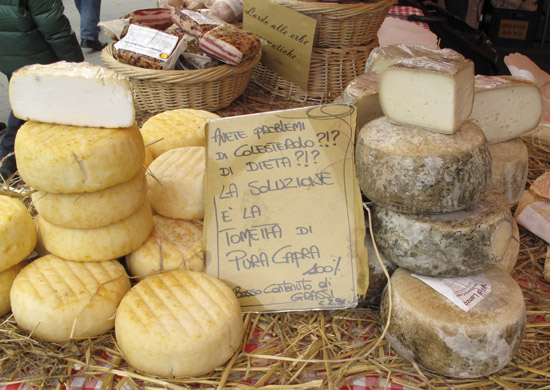
How about some deer meat salame?
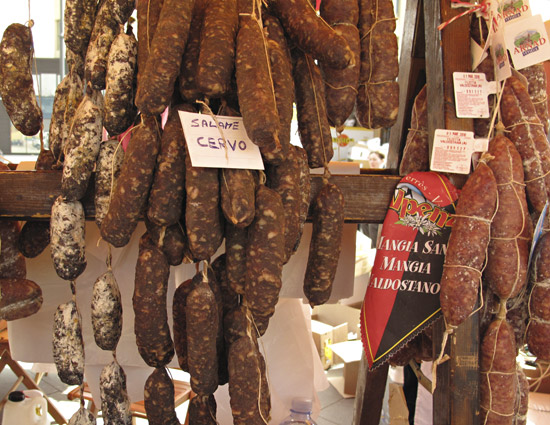
I sampled gorgonzola mixed with black truffle and bought a little tub of that to take home. Sampled from a big round of pecorino. Then walked up to a meat vendor that fed me enough samples that I didn’t need lunch. They offered huge, cased, cured meats from which they’d shave a piece and use the knife to hand it to me: prosciutto, porchetta, salame, soppressata. I tried them all, peppered and mild, whole, ground and chunked and knew I wanted to buy a piece. After all the samples, I was indecisive because I liked them all, but I bought soppressata.
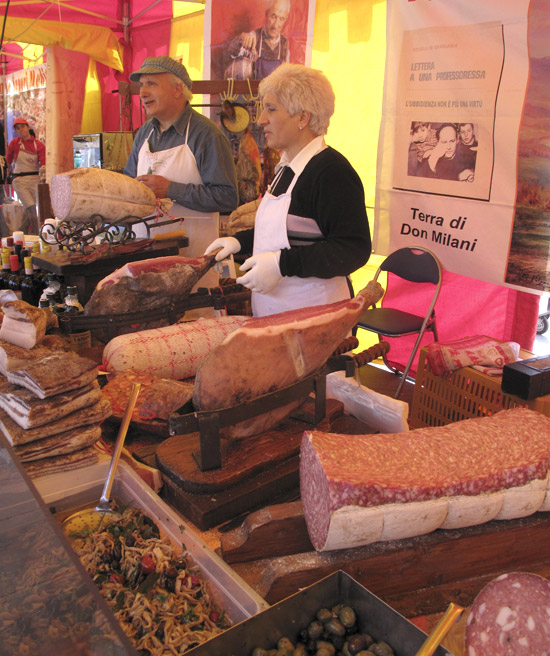
In the photo below, soppresatta is the large-chunk round near the black-rind cheese.
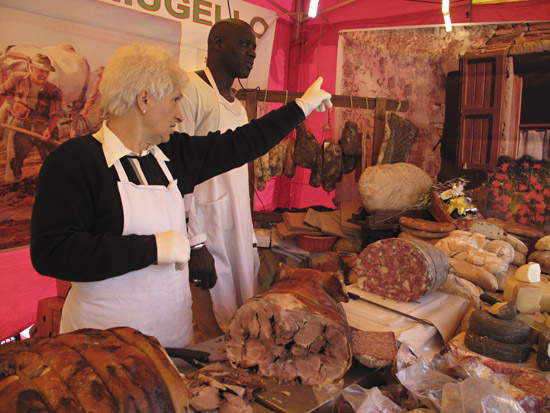
In nine months this is one meat I hadn’t tried yet because it’s a Tuscan meat and not so common up north. My markets don’t offer it. Soppressata is made of the left over parts of the pig: cartilage, tongue, head scraps… you name it, nothing’s wasted. The head is boiled for a few hours then picked of meat, skin and all “edible parts”. All of the picked bits are chopped large, seasoned, and stuffed into a casing about 10″ across. The broth from cooking is poured into the casing to cover the meat parts. It is then hung and the liquid thickens and binds everything into a solid. (In the U.S., it might be called “head cheese”.)
The soppresatta that this vendor offered had a nice peppery bite to it. Soppressata omelette? Soppressata burger? “They” are saying that soppressata pizza is the new big thing. I believe it.
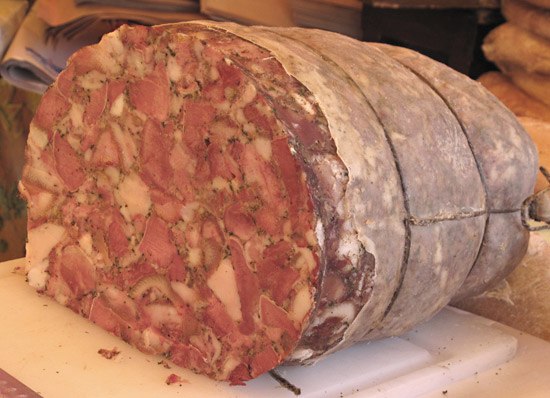
Here’s the front end of the porchetta – roast pig.

With gorgonzola and soppressata in my bag, I continued walking. I should have bought a nice Tuscan bread to bring home on the train, but didn’t. I’ve always marveled at these HUGE loaves I see at the markets. Ask for some bread and they just whack off a chunk. These loaves are about 4 feet long.
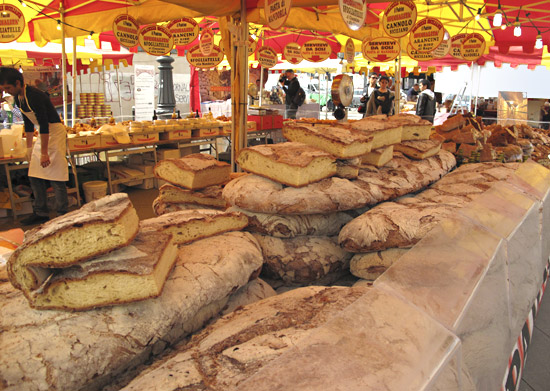
And look at this green olive bread!
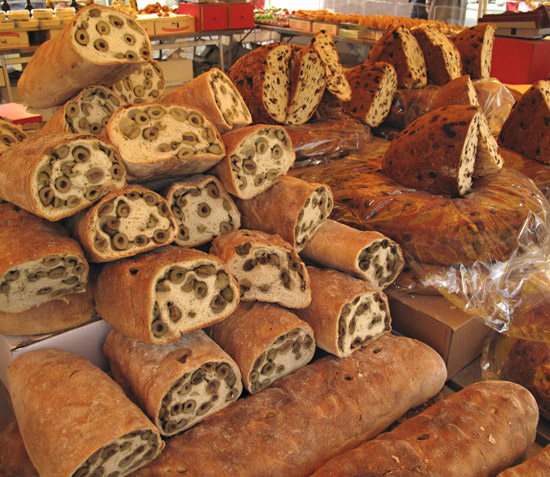
This Toma cheese is so beautiful to look at.
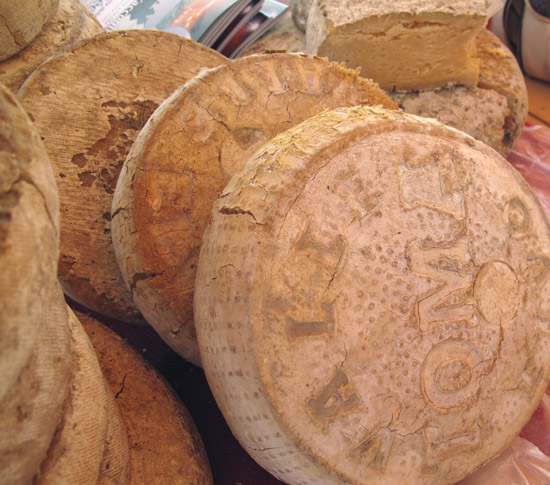
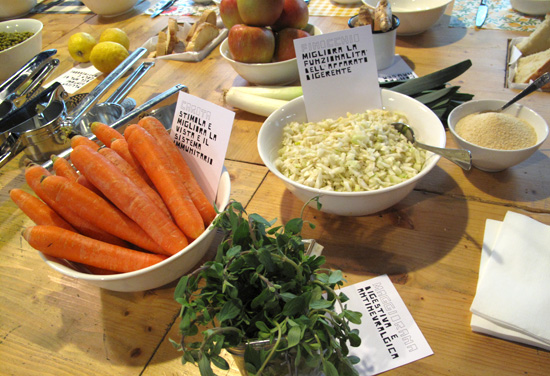
by Maureen | Mar 21, 2010 | Cheese, Discoveries, Featured Articles, Food!, Introspection, Journal, Meals, People, Photo of the Day, Photos
Would you let 30 random strangers eat off your plate? Would you, in turn, eat off the plates of those 30 strangers?
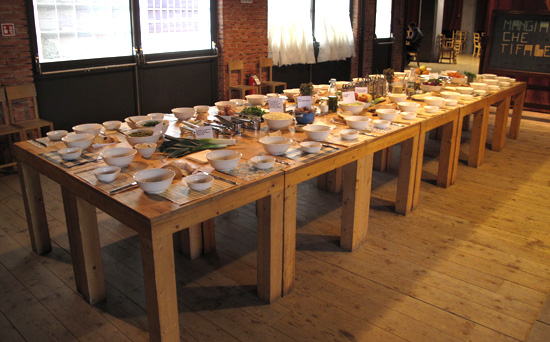
The Uovo Performing Arts Festival included one “performance” yesterday of 30 individuals, by reservation only. “Mangia che ti fa bene”, “Eat that you will feel well.” For 10 euro, or about $13.50, I walked into the room to a very long table with 30 place settings, and a variety of ingredients:
- bread
- water
- eggs
- grana cheese
- cabbage
- parsley
- apples
- beets
- sesame seeds
- pumpkin seeds
- fennel
- olive oil
- garlic
- spices
- cooked peas
- oats
- radicchio
- spinach
- fresh ginger
- lemon
- leeks
- carrots
- walnuts
- fresh herbs

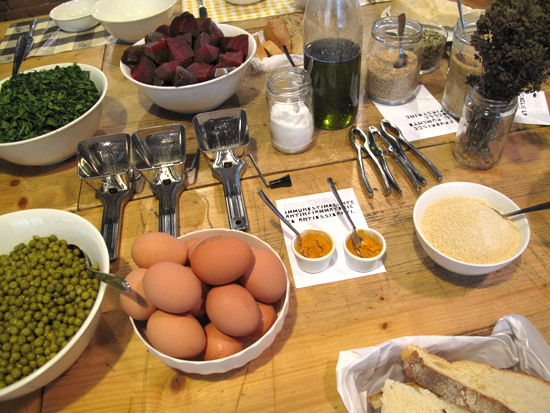
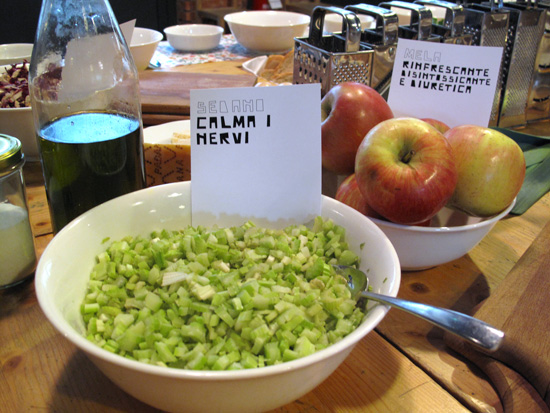
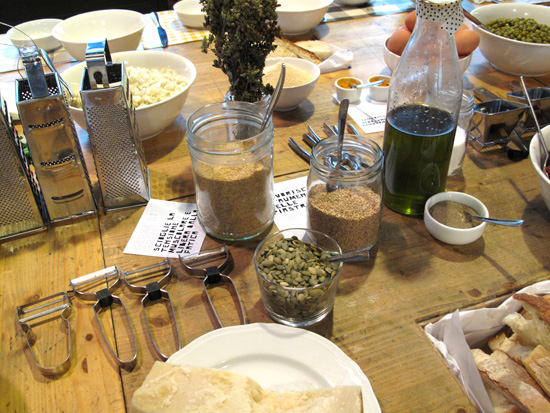
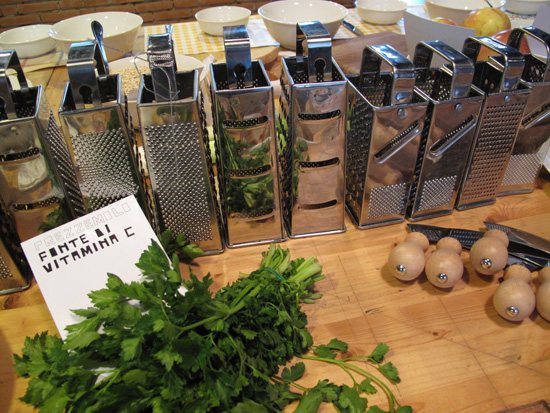
We were given limited, very loose guidelines.
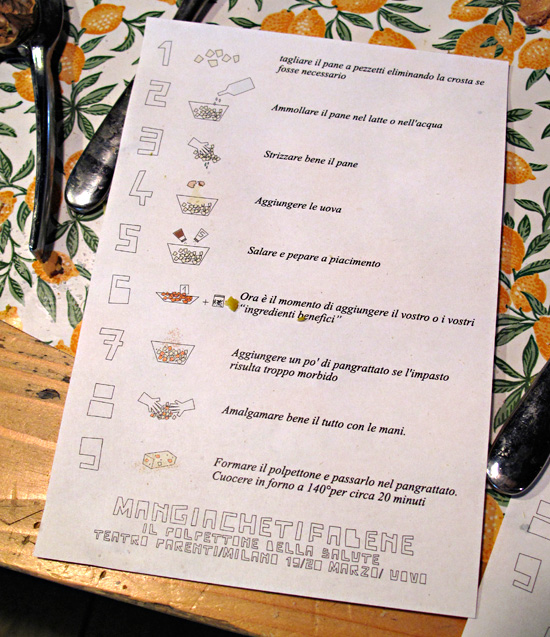
We each grabbed a plastic apron from the group taped to the window.
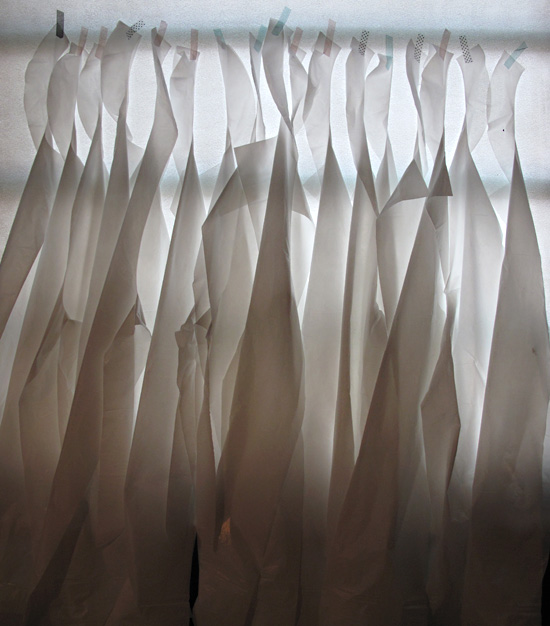
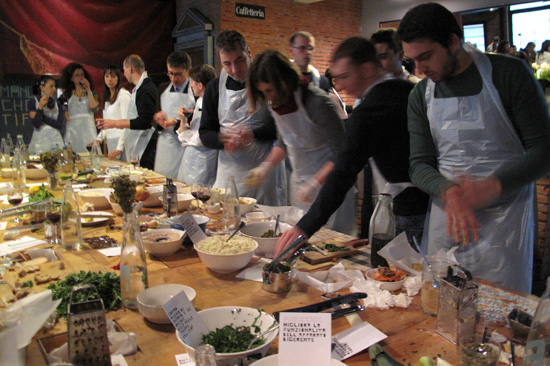
Our project was to gather whatever combination of ingredients we desired, blend them and put the mix into a paper-lined, 3″ x 5″ foil pan. The 30 of us were elbow-to-elbow at the table and we were being filmed. We had graters, sieves, knives, bowls, half-moons and cutting boards at our disposal. Notes were provided about the health-inducing properties of each food item.
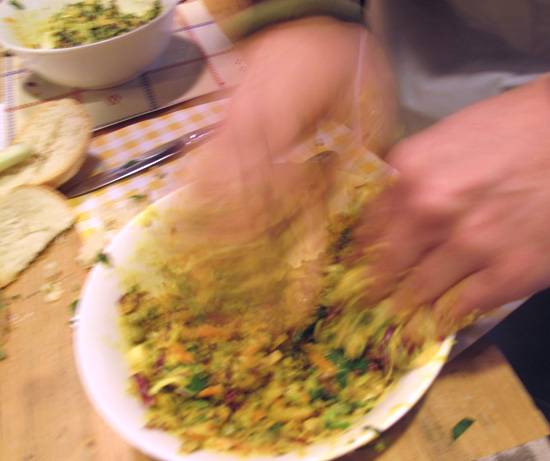
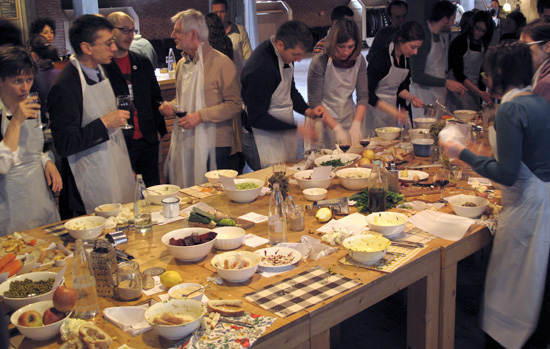
We asked for ingredients to be passed. We reached across the table. We laughed and chatted and mixed with our hands until our concoctions looked just right to us. Some pressed the ingredients through sieves for a uniform consistency. Others left chunks for spikes of flavor. Some formed loaf-like logs, while others patted their mix into flat casseroles. We bound up our creations in oven paper, scrawled our names on the wrap and sent the little tins off to be baked for 30-45 minutes.
While our dinners were baking, we were served lemon-slice salad, celery sticks with honey, and braised celeriac root. For our 10 euro, we also got a glass of red wine and some herb tea.
Trays of foil tins emerged from the oven, and the hostess called out names. One-by-one, the “performers”, the dinner guests, opened and tasted their creations. There were 30 recipes at the table. Like a groundswell, the sampling started. People reached over with their forks and sampled their neighbors’ meals, and everyone started passing their dish around for others to taste. It was remarkable the range of culinary directions we had each taken. I realized later that I could have gone in the sweet direction and combined bread, egg, apple, ginger, lemon and arrived at a dessert to contrast with all the savory gratins at the table.
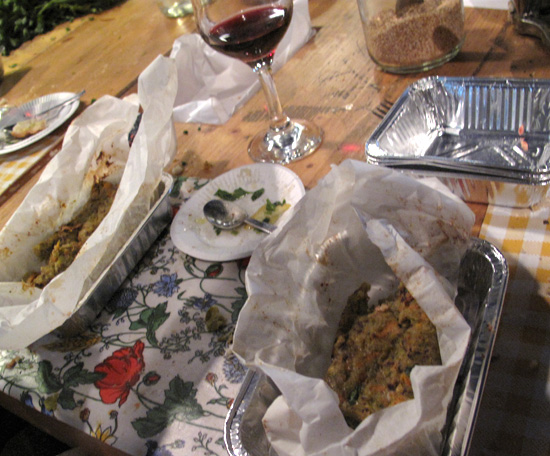
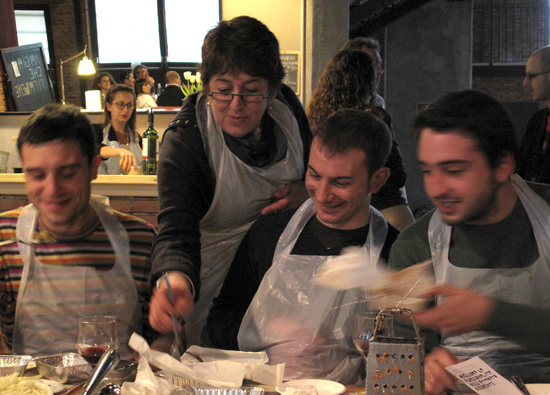
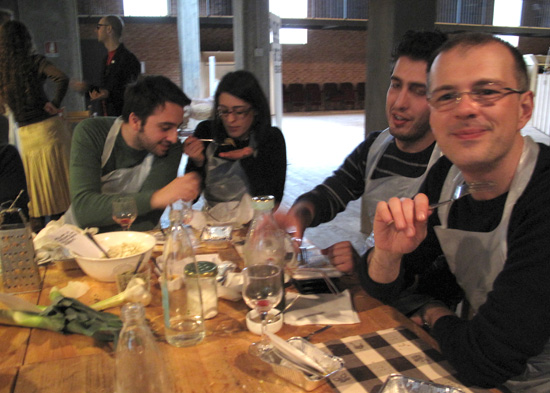
I looked around, tickled, chuckling and amazed. Would this happen in the U.S.? Could it? How could I bring this experience to Seattle? To Burien? I easily tallied that the 30 people at 10 euros each only brought in 300 euros. And I looked at all the food, and the utensils, and the wine and thought that surely this was not a money-making proposition. In the U.S., liability insurance alone for a one-day event of this nature would probably be prohibitive.
And would people in the U.S. be willing to pass their dish for their unknown neighbor to sample from, and then fork a bite from their neighbor’s plate and relish the combination of ingredients different from their own?
This does give me ideas for an uncommon Thanksgiving dinner… but many in my family would likely balk at the idea. (But they wouldn’t be random strangers.)
– – – –
Here’s the official, “as advertised” description of the event:
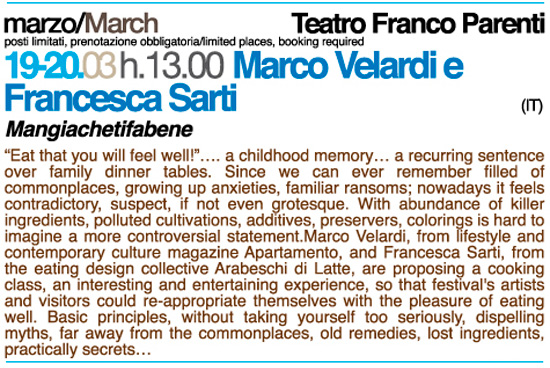
The aftermath was a mess of a table!
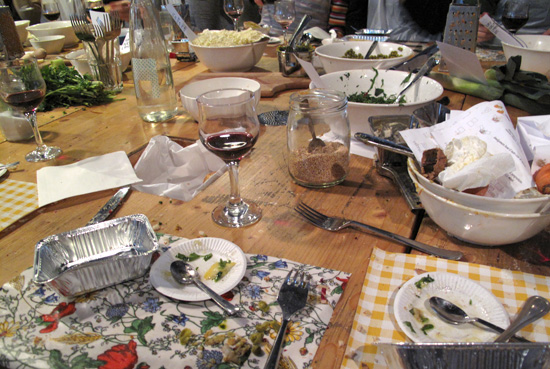
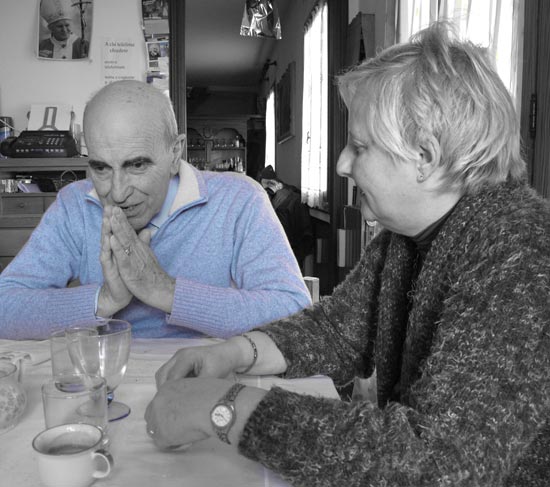
by Maureen | Mar 1, 2010 | Cheese, Featured Articles, Food!, Incredible Locations, Journal, Meals, People, Photos, Sanremo
Dinner the night before was followed by a long lunch the next day. Renata and Angelo, who live in a town within walking distance from Sanremo, were having some friends over on Sunday and I was invited to come along. So gracious! It’s a real treasure to have people open their doors and ask me to join them in their homes.
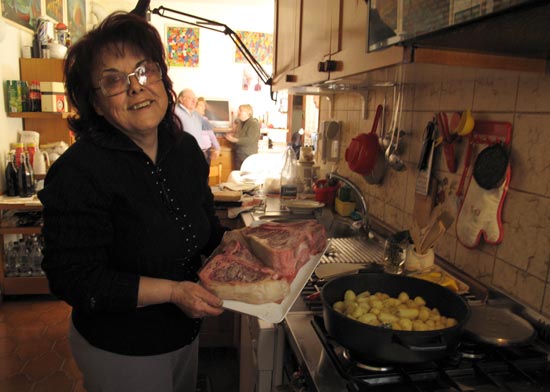
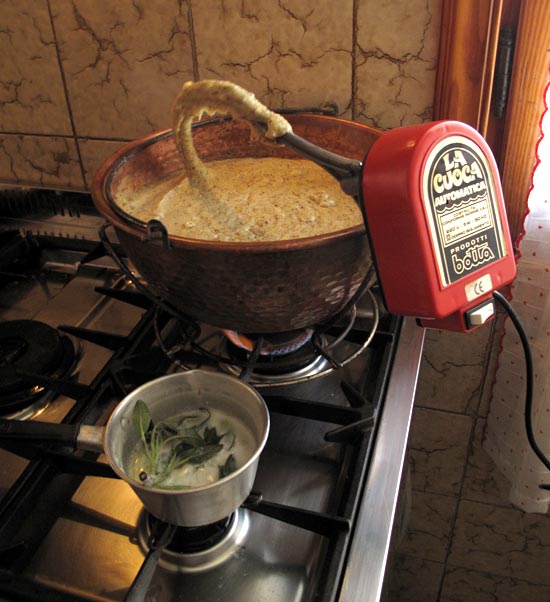
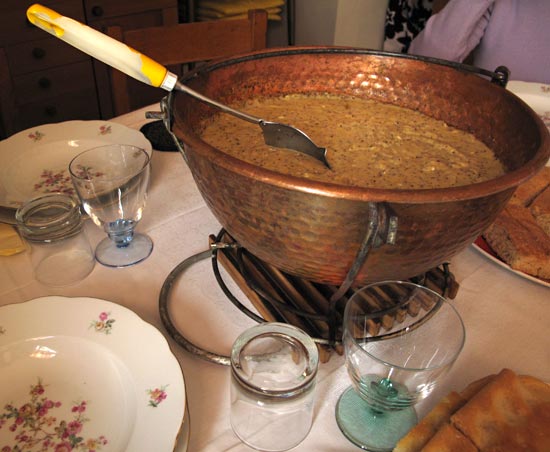
By a little before one o’clock, 8 people had clustered in the kitchen and around the dining table. Renata and Angelo had been cooking all day for us and piled the table high:
- Genovese focaccia – plain, with oil.
- Sardenara – Ligurian specialty focaccia with tomato sauce,
anchovies, olives, oregano and garlic.
- Carciofi Impanati Friti – breaded, deep-fried, small young artichokes.
- Maiale Cicioli – breaded, deep-fried pieces of pig fat.
- Patate – little baby potatoes, roasted with olive oil.
- Polenta Taragna Concia – a regional style of polenta with ground buckwheat and 1 kilo of cheese. It cooked over the stove in a copper kettle for more than an hour, with a motorized stirring paddle to mix it and keep it from sticking.
- T-Bone Steaks – the thickest t-bones I’ve ever seen were grilled outside ’til rare. The meat was cut away from the bone, then sliced and served.
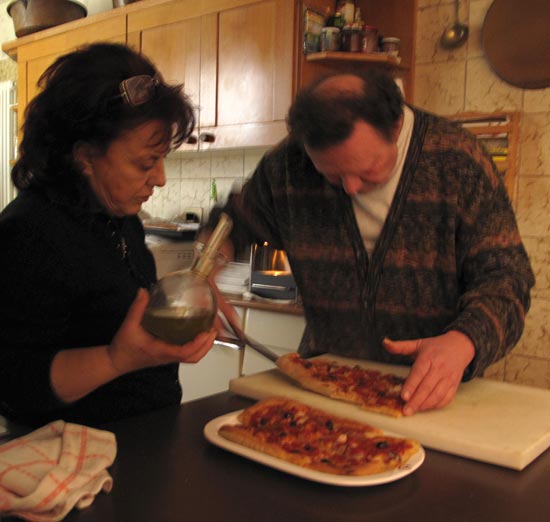
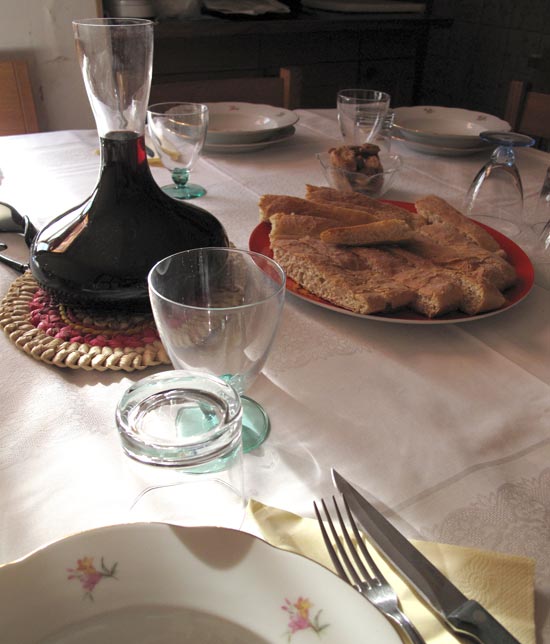
The sweets at the end of the meal included:
- Bugie – (which means “lies”) crispy, fried, sugar-dusted twists of dough.
- Nutella-topped sweet buns
- Baked Pears – Angelo got up from the table several hours into the afternoon and prepared baked pears by crushing amaretto cookies, mixing them with chocolate and liqueur, and pouring this blend onto the pears before quick baking.
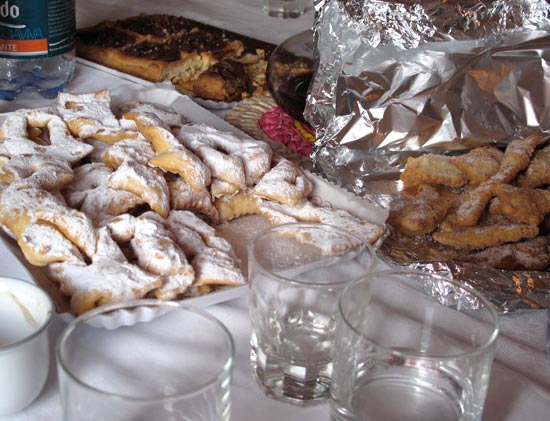
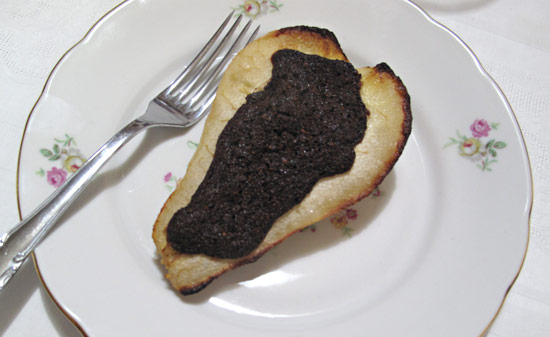
The food went around. The home-bottled chianti, extra-proof, flowed, as did the conversation. I understood most of it and jumped in when I had something to add. Though I had shot photos of Renata in the kitchen when I first arrived (feeling comfortable since we’d had dinner together the night before), I kept my camera tucked away for the first couple hours of the meal. These people didn’t know me and I didn’t want to be rude.
To lubricate the conversation, we had begun with the chianti, then moved on to champagne, grappa, rum and caffé. Time was passing and everyone was loosening up. I was treated to a display of classic Italian hand gestures, mannerisms and animated speech. So theatrical, you would have thought it had been scripted. Eventually, my camera came back out and I had fun snagging images as the hours ticked by.
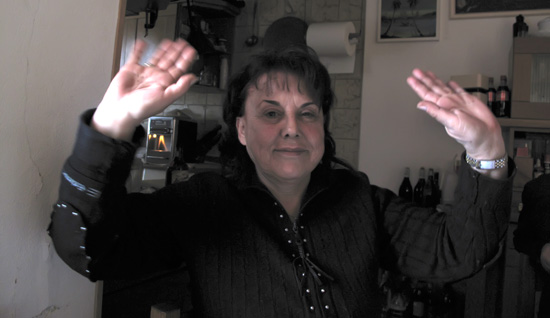
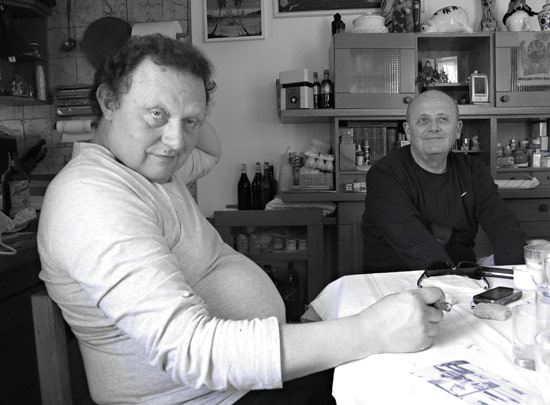
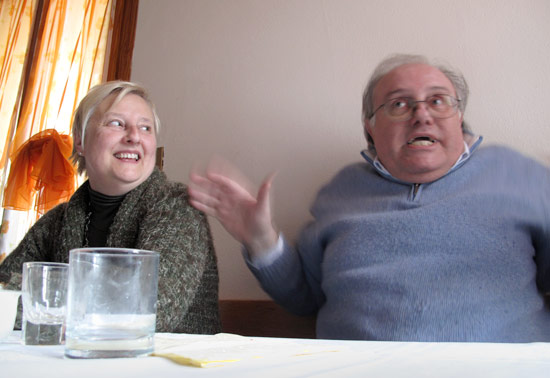

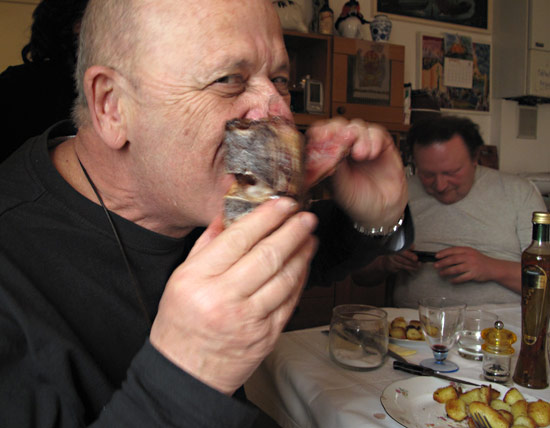
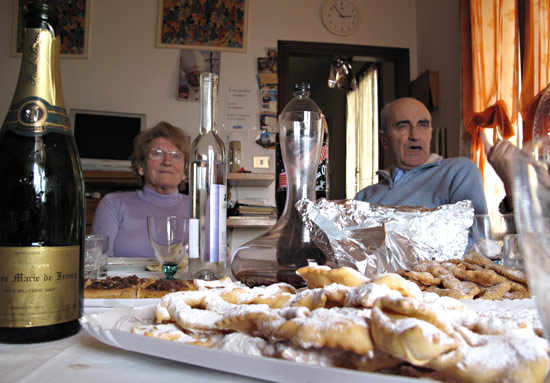
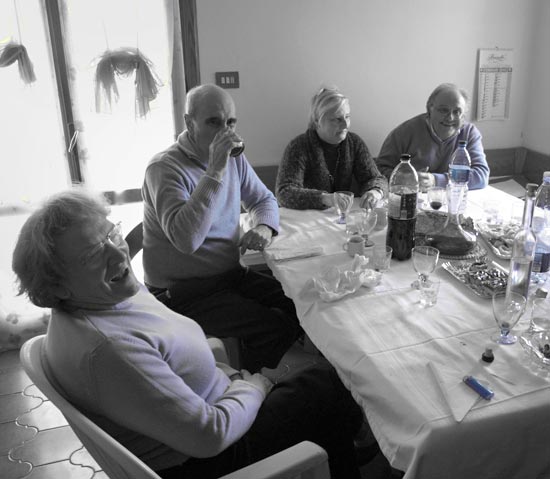
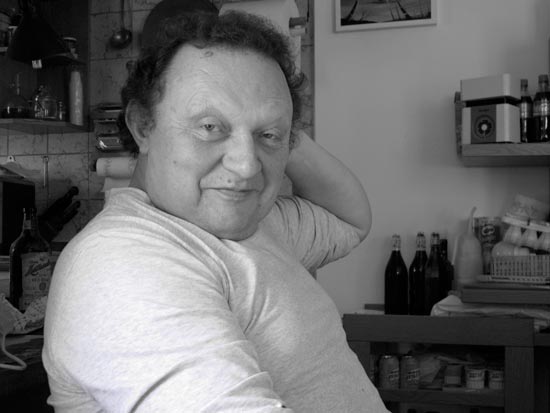
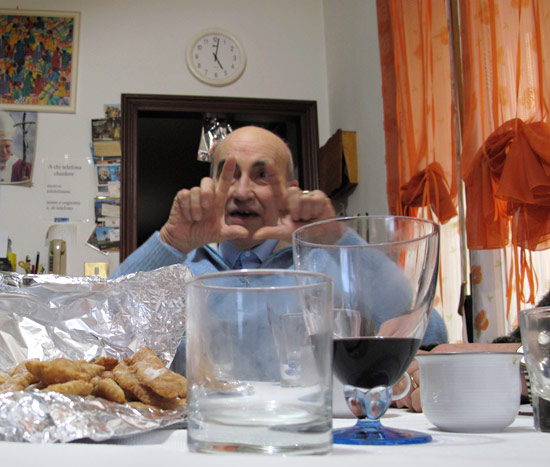
The first part of the day had been blue-sky serene, the kind of day that brings the crowds to the Ligurian* seaside. As we passed the afternoon in lively discussion at the table, the sky had darkened, a wind picked up and waves were crashing at Renata and Angelo’s bulkhead. It was time to go home at close to 7:00.
*Liguria is the “Italian Riviera”, that northern region of Italy that includes Cinque Terre at its southeastern end and arcs from there northwesterly to France.
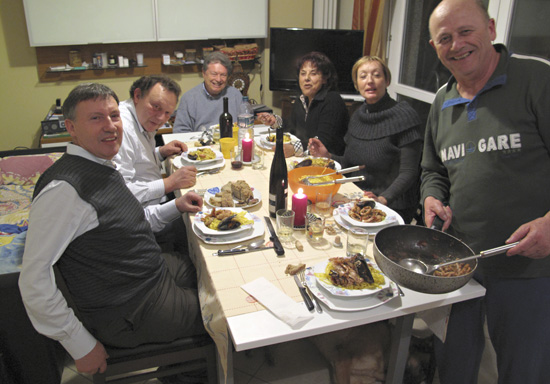
by Maureen | Feb 28, 2010 | Food!, Incredible Locations, Journal, Meals, People, Photos, Sanremo
It’s a natural for friends to gather for food and conversation. This is worldwide, but I find that the Italians do it well and do it often.
Last weekend, in Sanremo, seven of us got together for dinner around the table: my landlady, Sandra, and her husband, Mauro, and their friend, Sandro (all of whom I had spent the weekend with two weeks earlier), plus two friends of theirs, Renata and Angelo, and another friend of Sandro’s, Livio. Everyone came with food in hand, and we had a lively time.
Below, left to right: Livio, Angelo, Mauro, Renata, Sandra, Sandro.

We started with some salame that Livio had made. (Yes. Those are chunks of fat.) I had made a loaf of mixed-grain Irish Soda Bread that we ate with it.
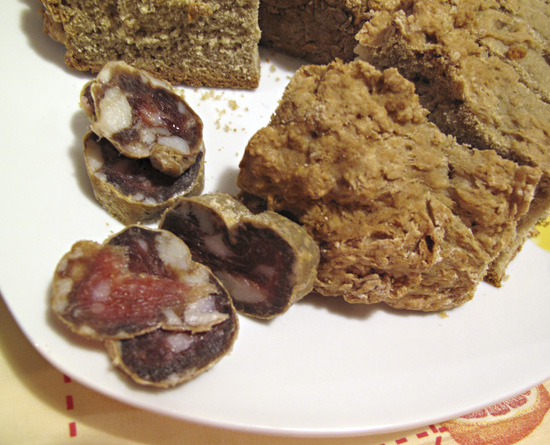
Sandro had cooked a fabulous mix of seafood, including mussels, shrimp, squid, pescatrice (that funny, deep-water fish with the “lure” hanging off the front of its head), and tiny 3 inch fillets of a local, sand-versus-mud fish. There was just a tad of hot pepper oil in this dish which added a touch of zing.
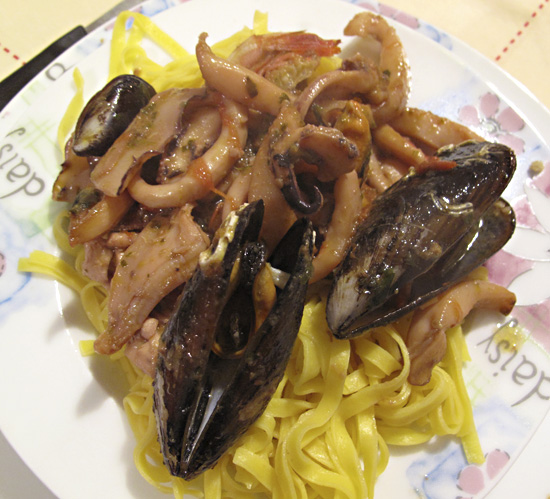
Renata had baked a fresh tart, beautiful with apple wedges emerging from the deep gold, dense, pound cake. This was pretty darned good with some of the array of gelato that Sandra and Mauro had picked up at the town’s best Gelateria. We ate and talked for close to three hours. (Yes. All in Italian.)
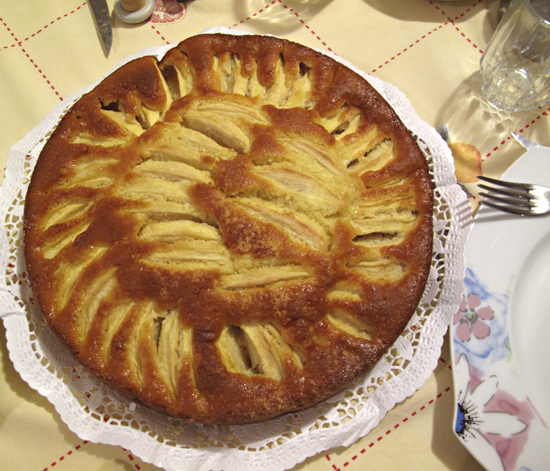
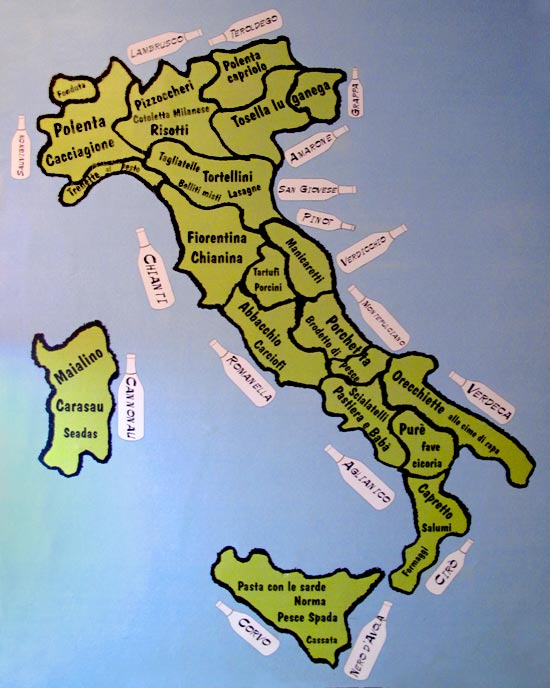
by Maureen | Feb 28, 2010 | Cheese, Food!, Introspection, Journal
In reading my blog posts about what I’m eating here, I hope that you’ll realize how much broader the Italian culinary range is than the stereotypical American concept of “Italian Food”. There is SO much more than pizza, spaghetti, lasagna and ravioli. “Fettucine Alfredo” is a figment of the American imagination, and I’ve been told emphatically, “NEVER serve tomato sauce on spaghetti!” Italians have laughed at that idea.
You can travel a mere 100 kilometers and encounter regional, traditional foods you couldn’t have found at your last stop. There are foods unique to specific communities!
As an example, depending on the region, the starch base will be different. You may encounter polenta, pasta (of a shape specific to that region), rice (risotto), focaccia or other bread. Wines, meats, cheeses and seasonings all vary by region.
For instance, in my last visits to Sanremo, I was treated to:
- Sardenara – a focaccia bread with tomato sauce, anchovies, garlic and olives (no cheese), specific to Liguria.
- “Branda Cugnon” – A delicious mash of salted, dried white fish (cod?), potato, parsley, olive oil and garlic. (Don’t ask about the bawdy origin of the name.)
- Rabbit with Sauce of Pureéd Rabbit Livers – A secret, family recipe in which the rabbit livers are pureéd with other ingredients (I’m not supposed to tell) until they become a thick, pink slurry. The sauce is then stirred onto the hot, stewed rabbit parts, and is “cooked” only from the residual heat.
- Polenta Taragna Concia – Yellow, coarse polenta (cornmeal) with ground buckwheat and a kilo of cheese stirred and cooked into it over the stove for an hour.
The next time you want to go out for “Italian Food”, stretch beyond what you’re familiar with and either go to a restaurant that offers more authentically prepared foods, or pick something off the menu other than your tried-and-true favorite. Order something you can’t identify. I do it all the time!
Below is a map that I saw on the wall at Ristorante Re Enzo in Bologna. It mentions just a few of the noted food and wine specialties for each region.


by Maureen | Feb 15, 2010 | Cheese, Featured Articles, Food!, Journal, Meals, People, Photos
We got together to celebrate Anaïs’s 24th birthday with traditional Milanese apperitivi at an “art bar” in town. Several of us women from Italian classes get together outside of class for chats, bike rides and travel. Anaïs is one of them.
She’s from Cannes, France, and 3 of her friends drove over, (bringing her kitty with them) to spend her birthday weekend. There were 10 of us together around the table, representing 5 countries: 4 French, 1 Portuguese, 1 Turkish, 2 Italian, 2 American, ranging in age from 24 to 40-ish… and me. The language changed depending on the speaker and the listener.
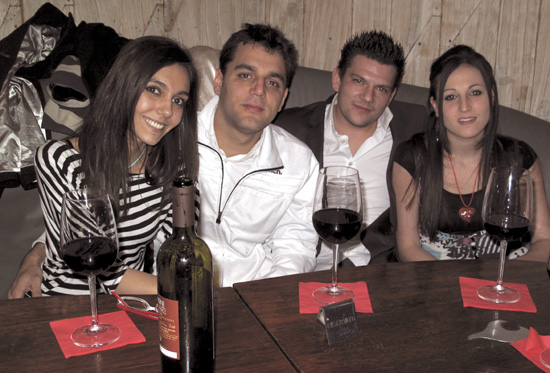
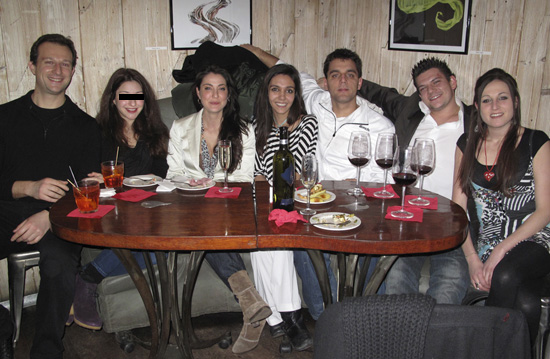
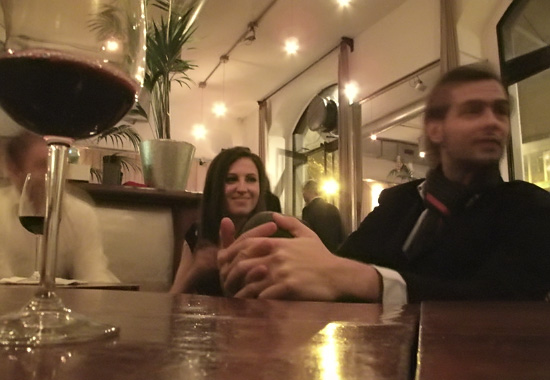
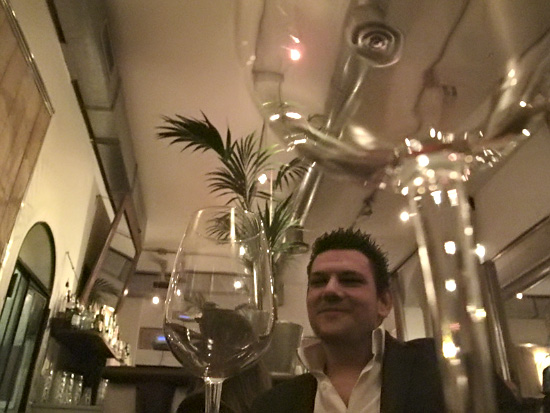
The Milanese apperitivi tradition allows you to go to just about any restaurant in town, buy one drink for 7 – 9 euro and eat as much as you want from the buffet of appetizers: pizza and foccacia squares, bruschetta, pasta, french fries (!), sliced meats, cheeses, risotto, mini-tarts. A better apperitivi offering will include such things as steamed mussels, veggie sticks, interesting salads, and other foods that are lower carb and more artfully prepared.
After our apperitivi, several of us went out for dinner at 11:30 p.m. to a Mexican restaurant, while the others went to the disco.

by Maureen | Feb 8, 2010 | Discoveries, Featured Articles, Incredible Locations, Journal, Monte-Carlo Monaco, Photo of the Day, Photos
We continued on to Monaco and the Casino Monte-Carlo. Who’d have imagined? All of us commented on the richness so thick you could cut it with a knife, that you could smell the money in the air. Subtlety and understatement are not included in the vocabulary of this pinpoint country. Monaco is a place of overstated extravagance.
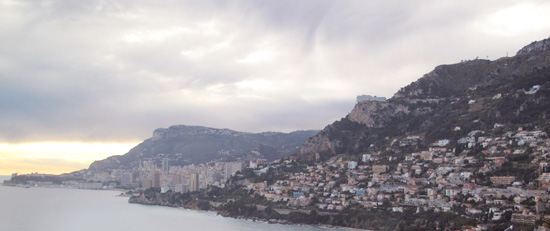
Monaco is the cluster of high-rises tucked into the rounded bay in the distance.
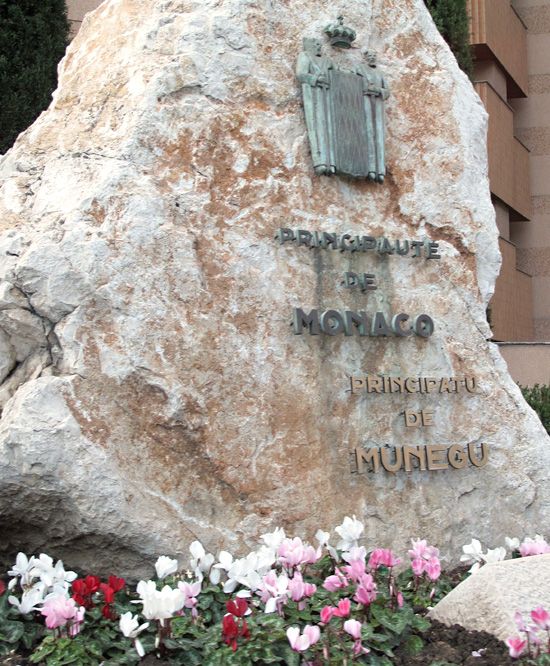
This is the marker stone as we entered into the principality of Monaco.
This small, independent principality is formed of a half-moon bit of the southeastern shore of France, not far from the border into Italy. There are two grand marinas hosting yachts beyond belief. Hotels circle the casino; their other homes are all the great cities of the world. The Grand Prix route is painted with the racer’s checkboard. All the finest shops for jewels and clothing have a presence in Monte-Carlo.
Monaco (and the district of Monte-Carlo) are Disneyland-style, exaggerated caricatures of way-over-the-top excess. For me, I can only imagine going there to drop my jaw, marvel at the ornamentation and know that I’ve seen it. I can’t imagine making it a serious destination, because it’s so far outside of my reach, my comprehension or even my desire.
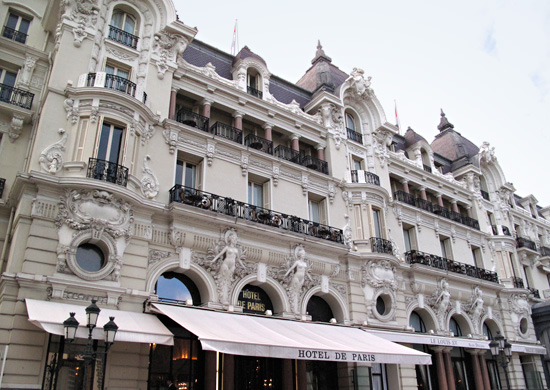
The front entrance of the Hotel De Paris, across the drive from the Casino Monte-Carlo.
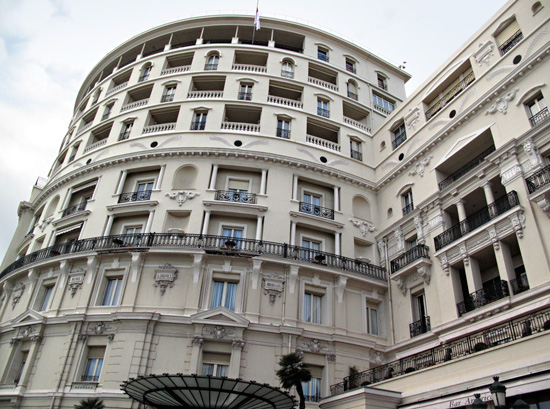
The seaside face of the Hotel De Paris.
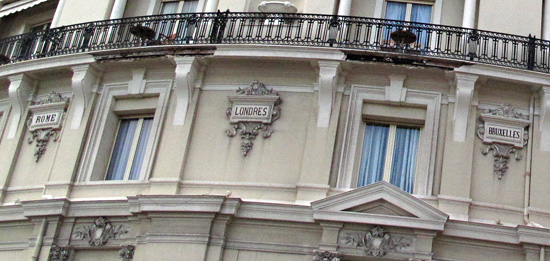
Grand city names round the arc of the Hotel De Paris.
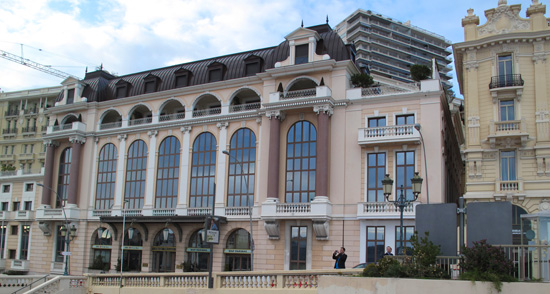
Even the newer construction reflects the style and extravagance of the old.
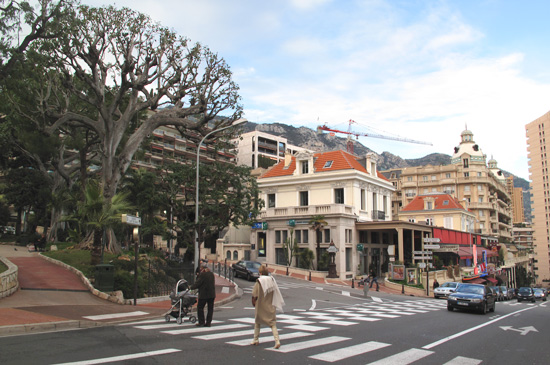
Checkerboard patterning on the Grand Prix raceway route.
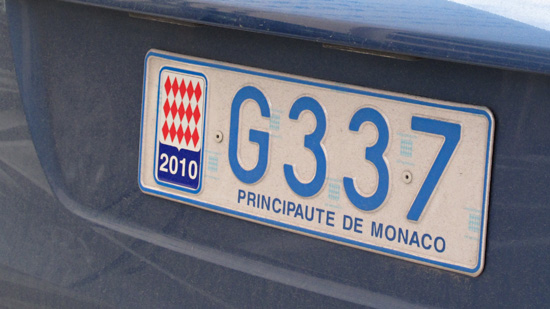
The Principality of Monaco.
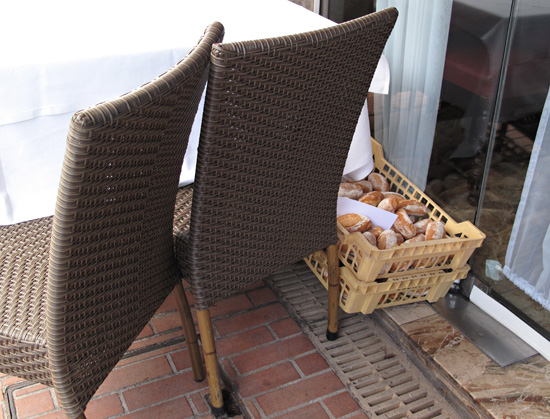
“Yes, we’d like to order some bread for the restaurant tonight.” “OK. No problem. We’ll bring it by and leave it outside by the door.” “Great. Thanks.” (Would this ever be allowed in the U.S.?)
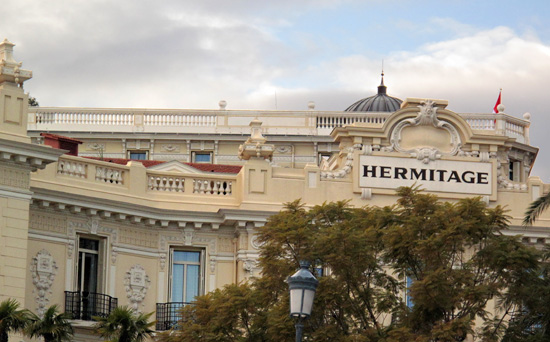
I’d heard of the Hermitage for years. Here it is.
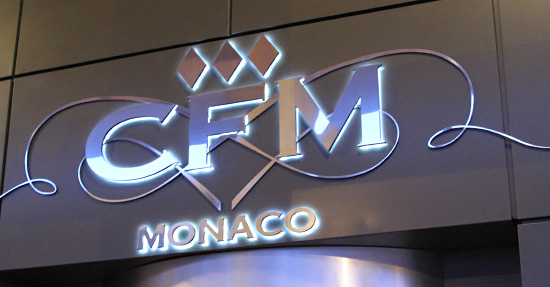
Even the signage has the same lux feel.
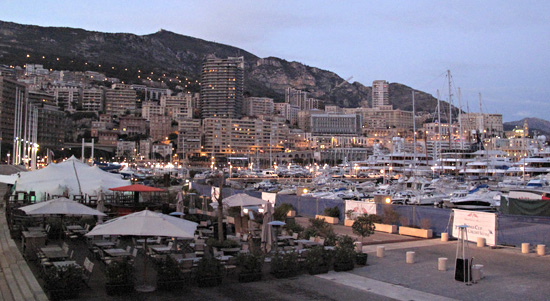
We got around to the other side of the bend in the bay just after sunset.
Monaco official website
Monte-Carlo official website
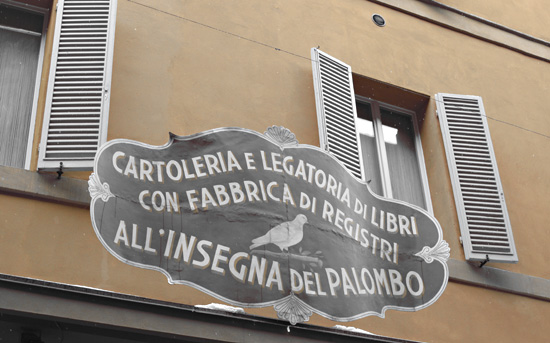
by Maureen | Feb 1, 2010 | Bologna, Cheese, Discoveries, Featured Articles, Food!, Graphics, Incredible Locations, Journal, Photo of the Day, Photos, Shopping & Markets
As a designer and artist, being here in Italy is a pilgrimage to the home of all the motifs, patterns and visual elements I’ve studied and heard of all my life. At times I’m overwhelmed, excited by the visually lush surroundings.
The storefronts and shop windows are delicious with their old-world signage and embellishments.
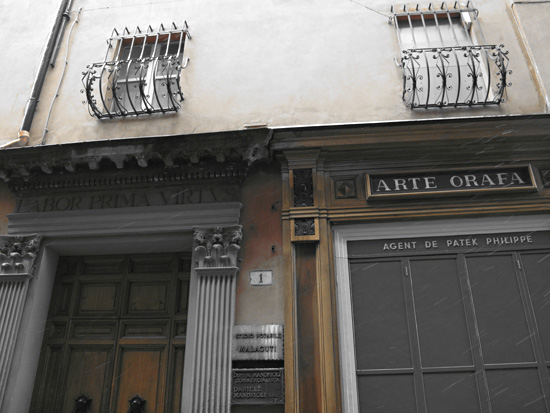

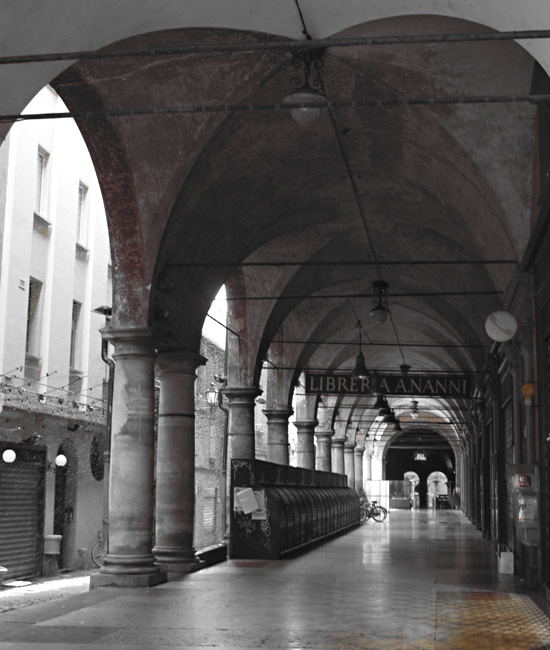
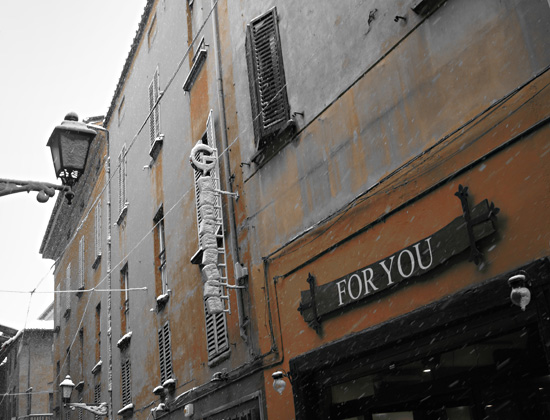
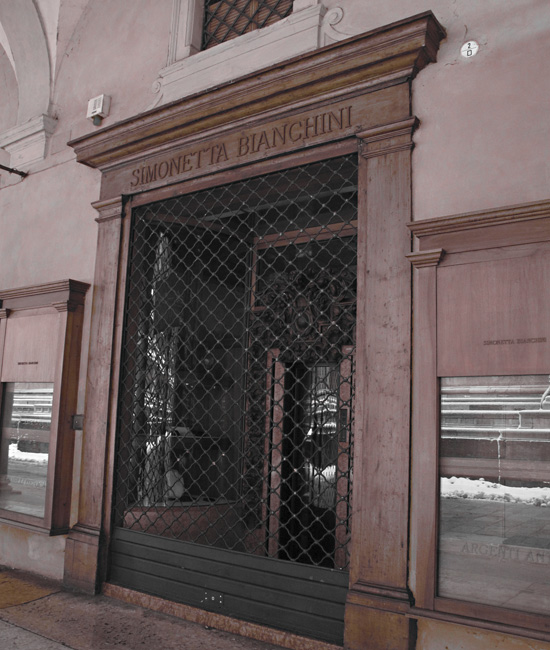
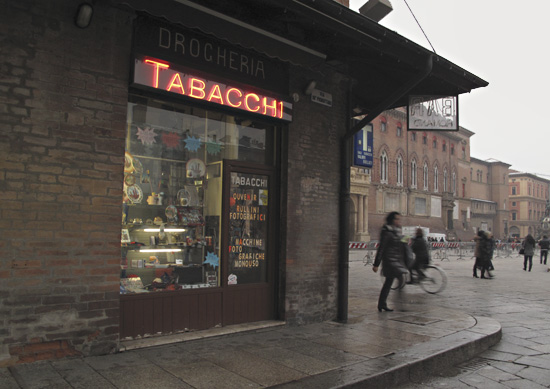
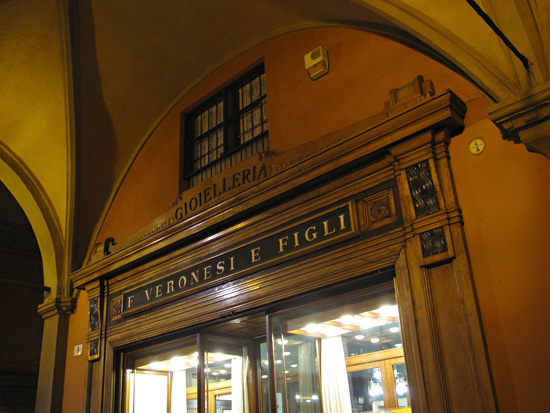
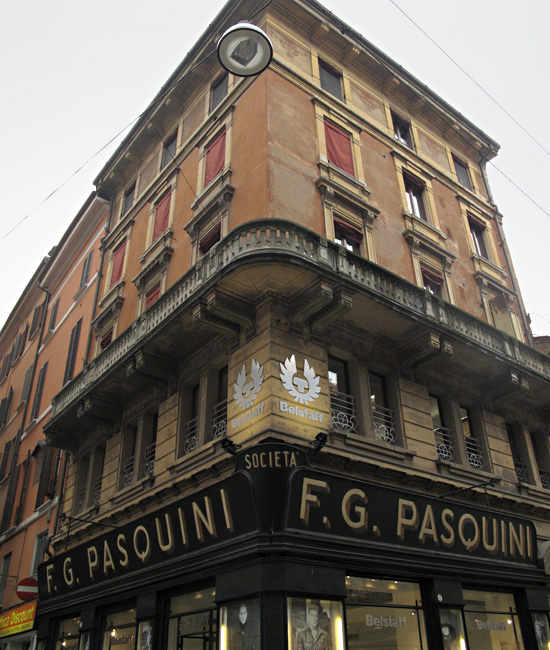
This is a contemporary storefront for a high-end clothing store. All of the furnishings are made of corrugated box stock, as well as the “chandeliers” at the ceiling.
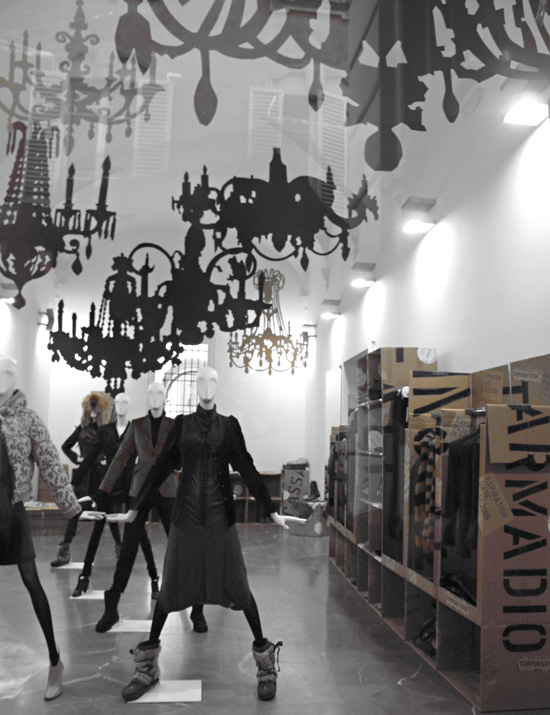
THIS is the place to buy Bolognese classic foods! The meats! The cheeses! The 40 euro ($60) 8 ounce bottles of balsamic vinegar! Mmm.
